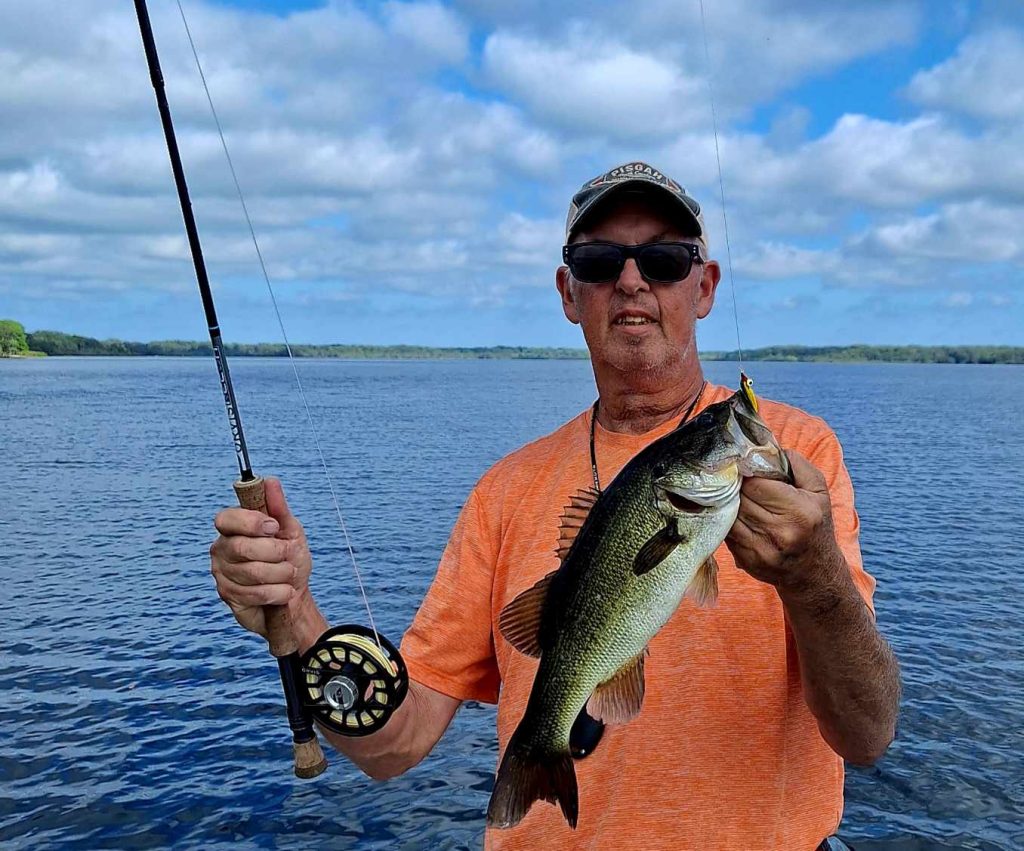
Fly Fishing for Largemouth Bass in Florida
The topic of this article will be fly fishing for largemouth bass in Florida. Largemouth bass are without a doubt the premier freshwater game fish species. Anglers come from all over the world to fish the first tile waters of Florida, which is prime habitat for largemouth bass.
Most largemouth bass caught by anglers are done so casting artificial lures as well as using live shiners. However, there is an underutilized fishery for those who enjoy fly fishing. You anglers target largemouth bass with a fly rod, and this is a mistake they are not that difficult to catch and put up a terrific fight while being caught in waters that often offer great scenery as well.
My name is Capt. Jim Klopfer I have been a full-time fishing guide in Florida since 1991. Most of my fishing was done and saltwater in the Sarasota area. As I got older, I focused more on river fishing charters for snook and bass as well as freshwater fishing, mostly bass and panfish.
Fly Fishing for largemouth bass in Florida
As with all fishing, a successful outing begins with understanding the habits of the quarry. Largemouth bass are ambush predators. They have a huge mouth which allows them to inhale prey of just about any size. Largemouth bass have a thick body and a broad powerful tail, resulting in them being quite agile as well as having short bursts of speed.
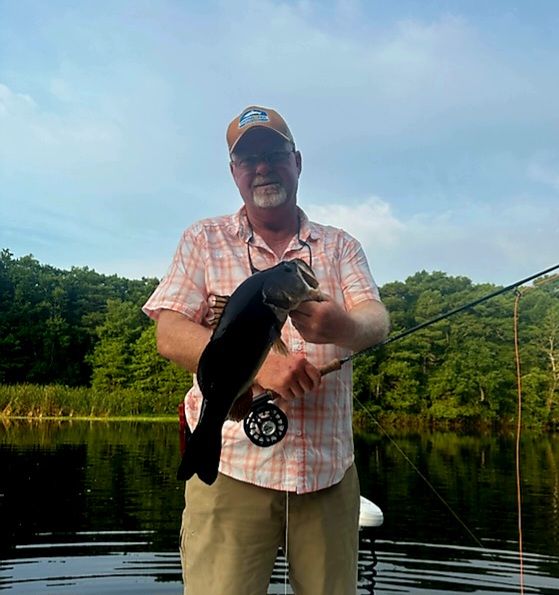
Largemouth bass are quite adaptable, and this is certainly one of their keys to success. They can live in a wide variety of environments and the list of forage that they will eat is literally endless. The same applies to cover, largemouth bass will take advantage of whatever cover offers protection.
Without a doubt, the primary cover that anglers will focus on when fly fishing for largemouth bass in Florida is vegetation. Boat docks will certainly harbor fish, but in the shallow for tile lakes of Florida, understanding the vegetation and how to successfully work it with a fly is critical to success.
Best tackle and flies
One of the aspects that I most enjoy about fly fishing for largemouth bass in Florida is the relative simplicity. There certainly are nuances that will result in more action, but overall this is fairly uncomplicated fly fishing. Anglers do not need to make long, accurate casts in order to be successful.
Read more about largemouth bass fly fishing charters
The best all round fly fishing outfit is a 9 foot 8wt rod with a matching reel and a floating bass taper line. For the most part, anglers fly fishing for largemouth bass in Florida will do so in fairly shallow water. Floating lines are the easiest to cast stay up out of the vegetation better. Special bass taper lines are heavy at the end and allow anglers to push the line as well is a bulky popper or other fly through the wind.
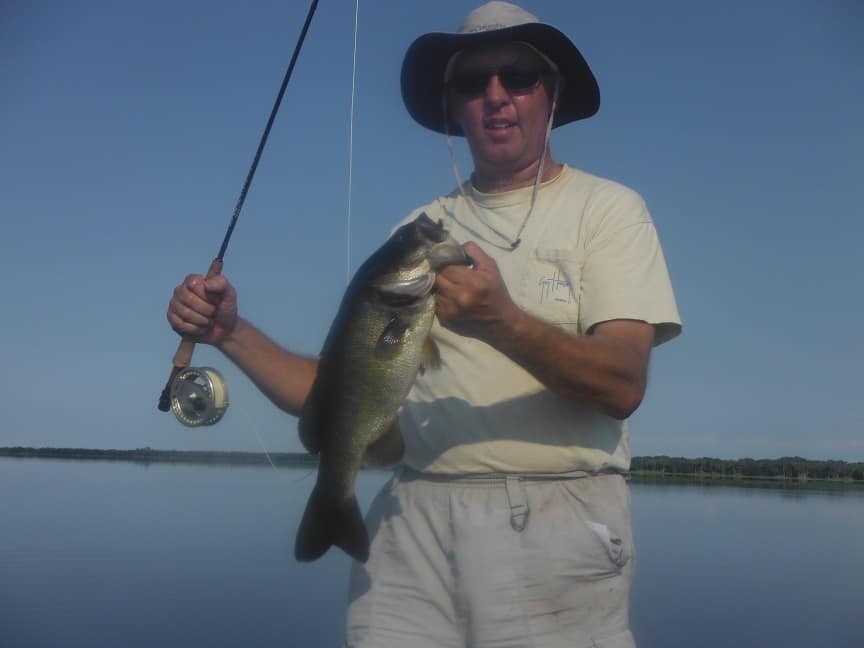
Long leaders are not required when fly fishing for largemouth bass. In most situations the water is tannin colored, so long thin leaders are not needed. Also, the fly’s generally used are fairly bulky and it can be difficult to turn over a long leader. I like to keep my leaders simple, using 3 1/2 feet of 50 pound butt section followed by 2 1/2 feet of 30 pound fluorocarbon tippet. Unless anglers are fishing especially deep, this literal work in just about every situation that a fly angler will encounter when chasing largemouth bass in Florida.
Top fly patterns for bass
In keeping with the theme of simplicity, I limit my fly selection to a few basic choices. It has always been my philosophy when fishing that location and presentation are by far the most important factor. Whenever possible, I like to use a popping bug as nothing beats the excitement of the surface strike. I do like my bass poppers to have a weed guard to limit fouling in the grass and other vegetation.
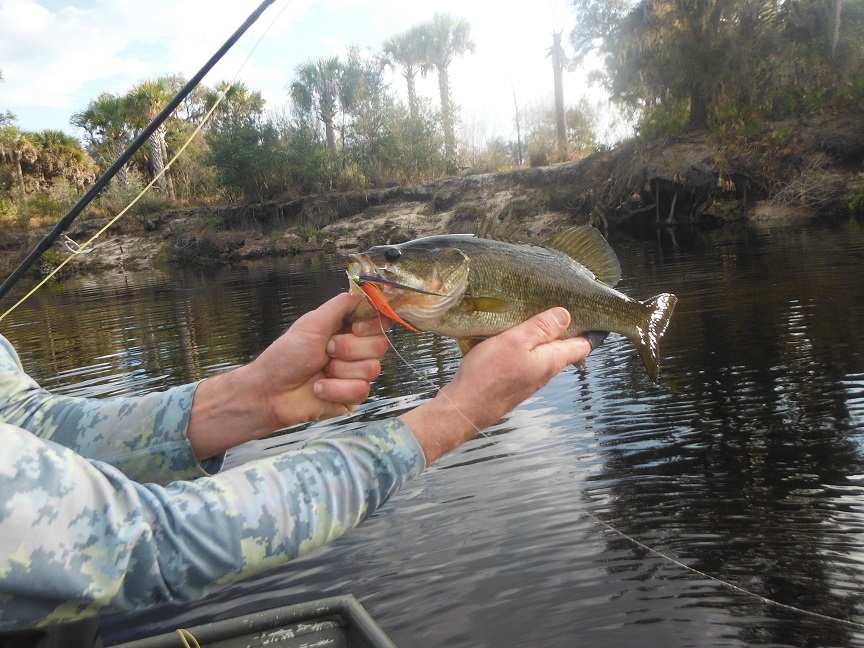
There are certainly situations when anglers will have to go to a subsurface fly. This may be when the water is cold or in the middle of the day when the sun is bright and bass are hunkered down in the cover. If I had to use one fly to fish with for largemouth bass in Florida it would be a # 1/0 black woolly bugger. I like to tie these with a fairly large marabou tail to give it bulk and action. Olive is a good color as well.
The other fly that I will use is a Clouser Minnow, usually and white or chartreuse over white. This is an excellent choice when bass are seen feeding on bait fish in open water as well as in clear water situations where a bit more finesse is required.
Successful techniques for fly fishing for bass in Florida
Anglers fly fishing for largemouth bass will be a bit more limited in where they can fish than those tossing lures or using live bait. The main issue when fly fishing for bass is simply dealing with the vegetation. Anglers need to find areas that have good vegetation that holds fish but yet is so thick that it’s impossible to fish without getting frustrated.
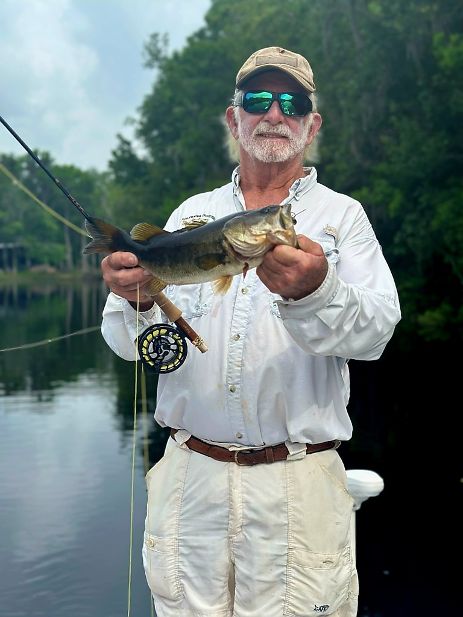
There is one technique that works when fly fishing for bass it is working the edges of aquatic vegetation. This can be lily pads, hydrilla, grass or any other type of vegetation. It is best to stay away from the thick moss as even flies with a weed guard will quickly accumulate on the hook.
I always start out fly fishing for largemouth bass in Florida with a popper. There are several reasons for this. First off, it is great fun and exciting to watch a bass devour a popper on the surface! No matter what the type of fishing, anytime a visual element can be added, it only increases the fun. Poppers can also be fished over top of submerged vegetation, especially hydilla. Bass will lie it ambush in open spots which anglers often cannot see, and then pounce on the unsuspecting prey. Deer hair bugs can also be use and are fished much in the same manner.
Popper fishing techniques
The technique for fishing with poppers is fairly simple, generally speaking, long casts are not required, 30 feet to 40 feet will usually get the job done. The popper is cast out and allowed to settle. It is important to not be in a hurry as the popper or bug sitting there will often draw a strike on its own. After it has settled, the angler points the rod directly at the popper and using the stripping hand gives the fly line a short, sharp pull. This will result in the nose of the popper digging into the water and creating the signature popping sound.
This action is repeated several times. If no take occurs, the popper is cast out again to a different spot close by. There is no reason to work the popper all the way back in, most strikes will occur within the first few feet of the cast. While the angler is not moving the popper a lot, this is actually a very efficient way to cover quite a bit of water. When casting lures, anglers have to real the lure and through a lot of unproductive water. This is not the case is a fly angler can simply lift up the popper and cast it to another likely looking spot quickly and easily.
When a largemouth bass takes the popper, it is very important to wait until the weight of the fish is felt before striking. This can be difficult as the excitement of the surface strike will often cause the angler to pull the popper away from the bass. Once the weight of the fish is felt, the angler pulls sharply with the stripping hand that smoothly raises the rod tip. This is called a “strip set” and is used when fly fishing for largemouth bass, no matter what the fly. The hookup ratio using this method is much higher than when using the fly rod to set the hook as anglers often do when trout fishing.
Bass fishing with subsurface flies
As mentioned earlier, my favorite largemouth bass fishing fly is a black woolly bugger. It has bulk and action and largemouth bass find it irresistible at times. It mimics a variety of forage including crayfish, bait fish, and other aquatic insects. The main challenge when fishing subsurface flies is dealing with weeds and other vegetation. Anglers will do best to focus on edges of weed lines as well as open spots. It can also be fished around docks, fallen timber, bridges, and other man-made structure.
The fly is cast out and allowed to settle for a few seconds. With the rod tip is held low near the surface of the water and in a straight line with the fly, the angler begins stripping the fly back in. The best all around retrieve consists of 1 foot strips followed by a pause. The path is very important as this is often when the bass will strike. The flies slowly sinking within enticing action mimics wounded prey and signifies an easy meal for a bass.
Unlike popper fishing, I will generally work a subsurface fly about halfway back in before picking it up and casting again. Bass will often follow the fly out as well as simply covering more water where a fish may lie in ambush. Again, same as when fishing the popper, a strip set will result in more fish hook than simply jerking the rod tip.
Clouser Minnow
The Clouser Minnow is a very versatile fishing fly! In fact, it is by far my favorite saltwater fly. It was developed by Bob Clouser for smallmouth bass fishing on the Susquehanna River. It works on just about every game fish species, including largemouth bass.
I save this fly for a couple of specialty fly fishing situations. When shad spawns occur, largemouth bass will often be seen feeding on the surface. While they look quite active, they can be fussy as they are keyed in on very small bait fish. This is where a smaller fly such as a #1 or #2 Clouser Minnow can be deadly. White and chartreuse over white are my two favorite colors and this pattern.
I will also use this fly on days when largemouth bass are less active, such as after a cold front when the water is clear and cool. This can be the most difficult time to fish and is quite challenging. However, slowly working a Clouser in deeper water will draw a strike when nothing else will. Slight depressions are holes and an otherwise shallow flat, even if the difference is only a couple feet, can make all the difference in the world.
In conclusion, I hope that this article on fly fishing for largemouth bass in Florida will encourage anglers to give this underutilized technique a try!